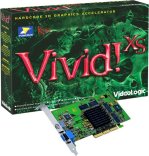The Board, The Chip
Because of the size of their business, the markets they operate in, and the retail penetration they should be able to attain, Hercules has been given a little free reign with KYROII before the other vendors start introducing theirs (although some vendors ignored this at CeBit, and told customers they would be producing KYROII based boards), which is why most of the previews we've seen so far have been based on the Hercules 64MB version of KYROII. Videologic has announced a 32MB version of KYROII, which is what has been handed to Beyond3D.
The board Beyond3D has is neither a reference board -- ST holds them and only has a few -- nor is it a retail KYROII Videologic Vivid!XS. This is a Videologic development board; it has all the features that we will see on Videologic's retail board, such as 32MB of SDRAM (as opposed to Hercules 64MB), a TV out, and a 175Mhz clockspeed. The only differences between this board and a retail KYROII Vivid!XS that I was made aware of was that this board is of 4 layer PCB design (the retail board will be 6 layer, which I've been told may be better for overclocking) and this board has active cooling (the retail Vivid!XS ships with passive cooling, although the clockspeed remains the same).
The actual feature set found in the KYROII chipset is exactly the same as that of KYROI; rather than explain those features again here, I'd urge you to read Page 1, Page 2 and Page 3 of Beyond3D's original KYRO Vivid! Review.
The Videologic Vivid!XS will ship with a similar installation CD as Vivid! did, which had the nice and easy to use HTML page layout, and also a plethora of demos. Also included will be a variation of the old 'Villagemark' overdraw / multitexture demo known at 'Templemark'; this has a distinctly Egyptian feel to it! The Vivid!XS drivers will also be familiar to Vivid! users with the same simple layout and functionality, but with a few more options available.
Below is a quick rundown of the KYROII chip / Videologic Vivid!XS specifications, and the features enabled:
KYROII Chip & Vivid!XS Board Specifications:
- 15 Million Transistors
- .18um Silicon Process
- 175Mhz Core Process
- 2 Pixel Pipelines; 1 Texture Unit Per Pipe
- 350Mpps / 350Mtps Fillrate
- 128bit Memory Bus
- 32MB SDRAM @ 175Mhz
- AGP 2.0 Compliant, AGP4X/2X
- 300Mhz RAMDAC
The KYROII chip feature set is as follows:
- PowerVR Tile Based Deferred Rendering
- 2 Trilinear pixels per clock
- 8-layer multi-texturing support
- Internal True Colour 32-bit ARGB internal rendering and layer blending
- 32-bit Z/stencil buffer
- Bump Mapping
- Emboss
- Direct3D environmental bump mapping (EMBM)
- Dot Product
- RGB Gouraud shading and specular highlights
- Bilinear, Trilinear and Anisotropic texture filtering
- Colour key and alpha blended textures
- Table and vertex fog
- Texture compression (S3TC/DXTC - DTX1 mode only)
- Full Scene Anti-Aliasing
- DirectX flexible vertex format support
- Full range of OpenGL and Direct3D blend modes
- 128-bit GUI accelerator with 3 operand ROPs, hardware clipping, colour expansion, transparent BitBLT and stretch BitBLT.
- Video playback and MPEG2 decode acceleration with motion compensation


